Identifying the Source of Heavy Metal Pollution and Apportionment in Agricultural Soils Impacted by Different Smelters in China by the Positive Matrix Factorization Model and the Pb Isotope Ratio Method
Abstract
1. Introduction
2. Materials and Methods
2.1. Research Area
2.2. Soil Sampling
2.3. Analytic Methods and Quality Control
2.4. Methods
2.4.1. The Pollution Index
2.4.2. The Nemerow Integrated Pollution Index
2.4.3. Positive Matrix Factorization Model
2.4.4. Isotope Ratio Method
2.4.5. Data Treatment and Statistical Analysis
3. Results and Discussion
3.1. Heavy Metal Pollution Analysis
3.1.1. Heavy Metal Concentrations
3.1.2. Heavy Metal Pollution Assessment
3.1.3. Spatial Distribution of Heavy Metals
3.1.4. Correlation between Heavy Metals
3.2. Source Apportionment by PMF
3.3. Source Apportionment by Pb Isotope Ratio Method
3.4. Analysis of Pollution Types in Smelter
3.4.1. Element Content Ratio
3.4.2. Element Contribution Ratio
4. Conclusions
- (1)
- The soils in the two research areas were both polluted by Cd, Pb, Hg, and Zn. The pollution contamination status of Zn in the Zhuzhou research area was slightly contaminated, while it was serious in the Huludao research area. In terms of spatial distribution, with the increase of the distance, the largest decreases of the main pollution elements concentrations in Zhuzhou research area were as follows, in declining order: Zn (72.65%) > Pb (64.29%) > Cd (22.97%) > Hg (21.88%). In the Huludao research area, the largest decreases of heavy metal concentrations declined in the order: Zn (93.82%) > Hg (87.19%) > Cd (28.67%) > Pb (19.34%). The difference in content reduction of Pb and Hg in the two research areas was related to the migration and sedimentation of smelting waste gas from the smelter with the atmosphere. Correlation analyses have shown that Cd, Pb, and Zn were significantly positively correlated with each other at 0.01 level in both research areas.
- (2)
- Based on the results of PMF, the contribution rate of heavy metals in agricultural soil around Zhuzhou Smelter was, in descending order: smelting source (37.6%) > agricultural source (26.9%) > natural source (22.4%) > mixed source of industrial activity and traffic (13.1%), while in the Huludao research area, it was as follows, in declining order: smelting source (34.1%) > agricultural source (29.4%) > natural source (24.3%) > mixed source of industrial activity and traffic (12.2%), indicative of the similarity between the source identification and apportionment of heavy metal in the two research areas. The contribution rates of the different pollution sources analyzed by Pb isotope ratio method were the lead smelting source (43.7%), followed by the agricultural source (34.6%), traffic source (14.2%) and natural source (7.5%), which were basically consistent with that of PMF. By complementing PMF and the Pb isotope ratio method to form a multisource analysis system, the results of heavy metal source analysis could be more reliable.
- (3)
- The results of the analyses using PMF and the Pb isotope ratio method have shown that the two smelters were the main cause of heavy metal pollution for the surrounding agricultural soil. By establishing the heavy metal element content ratio fingerprint and the contribution rate fingerprint of characteristic elements of the agricultural soil around the two smelters, it is suggested that the element content ratio in the Zhuzhou and Huludao smelters showed a similar and regular wavy distribution, and the contribution rate ratios of characteristic elements from smelting source to Cd/Zn, Pb/Zn, and Cd/Pb showed a similar distribution trend in the two research areas, with a ratio interval of (0.858, 0.978), (0.288, 1.259), and (0.529, 1.892), respectively. This may reflect the characteristics of heavy metal pollution in the surrounding agricultural soil around the smelter for soil pollution control decision making.
Supplementary Materials
Author Contributions
Funding
Acknowledgments
Conflicts of Interest
References
- Sharma, R.K.; Agrawal, M.; Marshall, F. Heavy metal contamination of soil and vegetables in suburban areas of Varanasi, India. Ecotoxicol. Environ. Safe. 2007, 66, 258–266. [Google Scholar] [CrossRef]
- Xiao, Q.; Zong, Y.T.; Lu, S.G. Assessment of heavy metal pollution and human health risk in urban soils of steel industrial city (Anshan), Liaoning, Northeast China. Ecotox. Environ. Safe. 2015, 120, 377–385. [Google Scholar]
- Bi, C.; Zhou, Y.; Chen, Z.; Jia, J.; Bao, X. Heavy metals and lead isotopes in soils, road dust and leafy vegetables and health risks via vegetable consumption in the industrial areas of Shanghai, China. Sci. Total Environ. 2018, 619, 1349–1357. [Google Scholar] [CrossRef] [PubMed]
- Shi, T.R.; Ma, J.; Zhang, Y.Y. Status of lead accumulation in agricultural soils across China (1979–2016). Environ. Int. 2019, 129, 35–41. [Google Scholar] [CrossRef]
- Zhu, Y.G.; Williams, P.N.; Meharg, A.A. Exposure to inorganic arsenic from rice: A global health issue? Environ. Pollut. 2008, 154, 169–171. [Google Scholar] [CrossRef] [PubMed]
- Zhao, F.J.; Mcgrath, S.P.; Meharg, A.A. Arsenic as a food chain contaminant: Mechanisms of plant uptake and metabolism and mitigation strategies. Annu. Rev. Plant Biol. 2010, 61, 535–559. [Google Scholar] [CrossRef]
- Li, Z.Y.; Ma, Z.W.; Kuijp, T.J. A review of soil heavy metal pollution from mines in China: Pollution and health risk assessment. Sci. Total Environ. 2014, 468, 843–853. [Google Scholar] [CrossRef]
- Alloway, B.J. Sources of Heavy Metals and Metalloids in Soils; Springer: Dordrecht, The Netherlands, 2013; pp. 11–50. [Google Scholar]
- Khillare, P.S.; Hasan, A.; Sarkar, S. Accumulation and risks of polycyclic aromatic hydrocarbons and trace metals in tropical urban soils. Environ. Monit. Assess. 2014, 186, 2907–2923. [Google Scholar] [CrossRef]
- Liang, J.; Zeng, G.; Gao, X. Spatial distribution and source identification of heavy metals in surface soils in a typical coal mine city, Lianyuan, China. Environ. Pollut. 2017, 225, 681–690. [Google Scholar] [CrossRef] [PubMed]
- Kuang, H.F.; Hu, C.H.; Wu, G.L.; Chen, M. Combining Principal Component Analysis (PCA) and Positive Definite Matrix Factorization (PMF), Source Analysis of Heavy Metals in Surface Sediments of Poyang Lake in High Water Period. Lake Sci. 2020, 32, 964–976. [Google Scholar]
- Dong, L.R.; Hu, W.Y.; Huang, B. Source apportionment of heavy metals in suburban farmland soils based on positive matrix factorization. China Environ. Sci. 2015, 35, 2103–2111. [Google Scholar]
- Munksgaard, N.C.; Batterham, G.J.; Parry, K.L. Lead isotope rations determined by ICP-MS: Investigation of anthropogenic lead in seawater and sediment from the Gulf of Carpentaria, Australia. Mar. Pollut. Bullt. 1998, 36, 527–534. [Google Scholar] [CrossRef]
- Komárek, M.; Ettler, V.; Chrastny, V. Lead isotopes in environmental sciences: A review. Environ. Int. 2008, 34, 562–577. [Google Scholar] [CrossRef]
- Wu, L.H.; Zhang, C.B.; Zhang, H.B. Application of Lead Stable Isotope in Source Identification of Soil Pollutants. Environ. Sci. 2009, 30, 227–230. [Google Scholar]
- Xie, W.C.; Peng, B.; Kuang, X.L. Lead isotopic geochemical tracing of heavy metal pollution sources in the sediments of the Changtan section of the Xiangjiang River. Geochemistry 2017, 46, 380–394. [Google Scholar]
- Hansmann, W.; Koppel, V. Lead-isotopes as tracers of pollutants in soils. Chem. Geol. 2000, 171, 123–144. [Google Scholar] [CrossRef]
- Liu, Y.; Wang, C.J.; Liu, H.; Feng, T.; Ma, H.Z.; Zhang, Q.H.; Sun, D.L. The application of lead isotope analysis technology in industrial park pollution source tracing. Techn. Equip. Environ. Pollut. Cont. 2015, 9, 3031–3036. [Google Scholar]
- Han, L.F.; Gao, B.; Lu, J.; Zhou, Y.; Xu, D.Y.; Gao, L.; Sun, K. Pollution characteristics and source identification of trace metals in riparian soils of Miyun Reservoir, China. Ecotox. Environ. Saf. 2017, 144, 321–329. [Google Scholar] [CrossRef]
- Lei, M.; Zeng, M.; Zheng, Y.M.; Liao, B.H.; Zhu, Y.G. Heavy metal pollution and potential risk assessment of paddy soil in Hunan mining and smelting areas. Acta Sci. Circum. 2008, 6, 1212–1220. [Google Scholar]
- Liu, C.H.; Yi, Y.L.; Zhang, D.G.; Zhu, H.G.; Yang, Y. Study on the status of soil cadmium pollution around Huludao Zinc Factory. Soil Bullet. 2003, 4, 326–329. [Google Scholar]
- Wu, S.T.; Wu, X.F.; Hu, Y.L. Study on soil pollution and heavy metal accumulation plants in Pb zinc smelter. Ecol. Environ. 2004, 13, 156–157. [Google Scholar]
- Li, L.L.; Wang, Y.S.; Zhang, D.G. Spatial distribution and pollution evaluation of soil lead in Huludao City. Soil 2006, 38, 465–469. [Google Scholar]
- Zhang, X.W.; Wang, Q.C.; Zheng, D.M. Spatial pattern and risk assessment of soil arsenic pollution around Huludao Zinc Plant. J. Agric. Environ. Sci. 2008, 5, 1769–1773. [Google Scholar]
- Chang, S.; Xu, W.D.; Huang, D.N.; Fu, J.X. Heavy metal pollution status and ecological risk assessment of soil around Huludao Zinc Factory. J. Hunan Ecol. Sci. 2017, 4, 8–14. [Google Scholar]
- Zhang, X.W. Analysis of Heavy Metal Pollution Sources in Soil and Rice in an Industrial Zone in Hunan; Chinese Academy of Agricultural Sciences: Beijing, China, 2019. [Google Scholar]
- Zhao, Y.R.; Gu, J.H.; Wan, W.; Zhang, H.; Wang, M.Q. Characteristics of heavy metal pollution and Pb isotopic tracing of farmland soil in Zhuzhou suburbs. Acta Sci. Circum. 2020, 40, 1074–1084. [Google Scholar]
- Xiao, C.; Ye, J.; Esteves, R.M.; Rong, C. Using Spearman’s correlation coefficients for exploratory data analysis on big dataset. Concurr. Comp. Pract. Exp. 2016, 28, 3866–3878. [Google Scholar] [CrossRef]
- Lu, J.B. China’s Rice Industry: Supply and Demand, Circulation and Future Policy Orientation: Speech at the World Rice Trade Conference of the First International Rice Conference. Chin. Rice 2002, 6, 11–13. [Google Scholar]
- Na, Z.; Wang, Q.; Zheng, D. Mercury contamination and health risk to crops around the zinc smelting plant in Huludao City, northeastern China. Environ. Geochem. Health 2007, 29, 385–393. [Google Scholar]
- Zhang, Z.S.; Wang, Q.; Zheng, D. Mercury distribution and bioaccumulation up the soil-plant-grasshopper-spider food chain in Huludao City, China. J. Environ. Sci. 2010, 22, 1179–1183. [Google Scholar] [CrossRef]
- Determination of Soil pH (NY/T 1377-2007); Ministry of Agriculture of the PRC: Beijing, China, 2007.
- Chinese Environmental Protection Administration. Environmental Quality Standard for Soils (GB 15618-1995); CEPA: Beijing, China, 1995.
- Soil Quality-Determination of Total Mercury, Total Arsenic and Total Lead-Atomic Fluorescence Method-Part 1: Determination of Total Mercury in Soil (GB/T 22105.1-2008); Standardization Administration: Beijing, China, 2018.
- Soil Quality-Determination of Total Mercury, Total Arsenic and Total Lead-Atomic Fluorescence Method-Part 2: Determination of Total Arsenic in Soil (GB/T 22105.2-2008); Standardization Administration: Beijing, China, 2018.
- Chen, T.; Liu, X.M.; Li, X. Heavy metal sources identification and sampling uncertainty analysis in a field-scale vegetable soil of Hangzhou, China. Environ. Pollut. 2009, 157, 1003–1010. [Google Scholar] [CrossRef]
- General Rules for Inductively Coupled Plasma Mass Spectrometry (DZ/T 0223-2001); Ministry of Ecology and Environment of the People’s Republic of China: Beijing, China, 2001.
- Chen, H.Y.; Teng, Y.G.; Li, J. Source apportionment of trace metals in river sediments: A comparison of three methods. Environ. Pollut. 2016, 211, 28–37. [Google Scholar] [CrossRef] [PubMed]
- Determination of Trace Lead Isotopic Composition in Rocks and Minerals (DZ/T 0184.12-1997); Ministry of Geology and Mineral Resources, PRC: Beijing, China, 1997.
- He, H.X.; Yu, R.L.; Hu, G.R. Pollution history and source of heavy metals in coastal sediments from Xiamen Western Bay. China Environ. Sci. 2014, 34, 1045–1051. [Google Scholar] [CrossRef]
- Chen, T.B.; Zheng, Y.M.; Lei, M.; Huang, Z.C.; Wu, H.T.; Chen, H. Assessment of heavy metal pollution in surface soils of urban parks in Beijing, China. Chemosphere 2005, 60, 542–551. [Google Scholar] [CrossRef]
- Soil Environmental Quality Standards for Risk Control of Soil Pollution on Agricultural Land (GB 15618-2018); Standardization Administration: Beijing, China, 2018.
- Chen, H.; Lu, X.; Chang, Y.; Xue, W. Heavy metal contamination in dust from kindergartens and elementary schools in Xi’an, China. Environ. Earth Sci. 2014, 71, 2701–2709. [Google Scholar] [CrossRef]
- Ma, L.; Yang, Z.; Li, L.; Wang, L. Source identifcation and risk assessment of heavy metal contaminations in urban soils of Changsha, a mine-impacted city in Southern China. Environ Sci. Pollut. Res. 2016, 23, 17058–17066. [Google Scholar] [CrossRef] [PubMed]
- Yari, A.A.; Varvani, J.; Zare, R. Assessment and zoning of environmental hazard of heavy metals using the Nemerow integrated pollution index in the vineyards of Malayer city. Acta Geophys. 2021, 69, 149–159. [Google Scholar] [CrossRef]
- Yan, Y.; Zhang, X.W.; Guo, B.L. Research progress of lead-cadmium-zinc-mercury stable isotopes in the analysis of heavy metal pollution sources. Environ. Chem. 2020, 39, 2712–2721. [Google Scholar]
- China National Environmental Monitoring Station. Background Value of Soil Elements in China, Beijing; China Environmental Science Press: Beijing, China, 1990. [Google Scholar]
- Xi, C.Z.; Dai, T.G.; Huang, D.Y. Distribution characteristics and pollution evaluation of soil heavy metals in Zhuzhou City, Hunan. Geol. China 2008, 3, 172–178. [Google Scholar]
- Liu, C.Z. Soil Heavy Metal Pollution and Potential Risk Assessment in the Main Watersheds of Hunan Province; Hebei Agricultural University: Baoding, China, 2011. [Google Scholar]
- Li, J.; Yang, Z.W.; Li, Y.; Tan, W.; Yuan, W.Z.; Jiang, J.Y. Comparative Study on the Effect of Two Receptor Models to Analyze the Source of Soil Heavy Metal. Environ. Sci. Res. 2020, 1–13. [Google Scholar]
- Abkhoshk, E.; Jorjani, E.; Al-Harahsheh, M.S.; Rashchi, F.; Naazeri, M.J.H.V. Review of the hydrometallurgical processing of non-sulfide zinc ores. Hydrometallurgy 2014, 149, 153–167. [Google Scholar] [CrossRef]
- Cheng, Y.X.; Zhao, Z.S.; Wang, Y.Z.; Qiu, K.Y.; Fu, Y.L.; Zhao, E.S.; Li, L.P. Heavy metal pollution characteristics of farmland soil near a lead smelter in Henan Province. Soil Bullet. 2014, 45, 1505–1510. [Google Scholar]
- Zhang, C.; Huang, L.; Luan, T. Structure and function of microbial communities during the early stages of revegetation of barren soils in the vicinity of a Pb/Zn smelter. Geoderma 2006, 136, 555–565. [Google Scholar] [CrossRef]
- Bi, X.; Feng, X.; Yang, Y.; Qiu, G.; Li, G.; Li, F.; Jin, Z. Environmental contamination of heavy metals from zinc smelting areas in Hezhang County, western Guizhou, China. Environ. Int. 2006, 32, 883–890. [Google Scholar] [CrossRef] [PubMed]
- Douay, F.; Pruvot, C.; Roussel, H. Contamination of urban soils in an area of northern France polluted by dust emissions of two smelters. Water Air Soil Pollut. 2008, 188, 247–260. [Google Scholar] [CrossRef]
- Xu, L. Statistical Analysis and Numerical Simulation Study on the Characteristics of Severe Convective Weather in Hunan; Nanjing University of Information Technology: Nanjing, China, 2011. [Google Scholar]
- Guo, L.Y.; Liao, Y.F.; Li, J. The construction of historical wind and hail disaster sequence in Hunan and its changing characteristics. Dis. Sci. 2018, 33, 122–127. [Google Scholar]
- Chai, S.W.; Wen, Y.M.; Zhang, Y.N. Characteristics of heavy metal content in agricultural soils in the suburbs of Guangzhou. China Environ. Sci. 2003, 23, 592–596. [Google Scholar]
- Guo, G.H.; Wu, F.C.; Xie, F.Z. Spatial distribution and pollution assessment of heavy metals in urban soils from southwest China. J. Environ. Sci. 2012, 24, 410–418. [Google Scholar] [CrossRef]
- Andreas, A. Magmatic-hydrothermal evolution in a fractionating granite: A microchemical study of the Sn-W-F mineralized Mole Granite (Australia). Geochim. Cosmochim. Acta 2000, 64, 3373–3393. [Google Scholar]
- Wei, J.X.; Cen, K.; Zhao, L.S. Discussion on the genesis of the forward zoning of magma-hydrothermal deposits. Min. Res. Geolog. 2018, 32, 65–71. [Google Scholar]
- Safarzadeh, M.S.; Bafghi, M.S.; Moradkhani, D. A review on hydrometallurgical extraction and recovery of cadmium from various resources. Miner. Eng. 2007, 20, 211–220. [Google Scholar] [CrossRef]
- Ai, J.C.; Wang, N.; Yang, J. Analysis of soil heavy metal sources in Jiapigou gold mining area based on UNMIX model. Environ. Sci. 2014, 35, 3530–3536. [Google Scholar]
- Huang, D.W.; Gui, H.R. The characteristics and source analysis of soil heavy metals in Sunan mining area. Earth Environ. 2017, 45, 546–554. [Google Scholar]
- Jiao, W.; Chen, W.; Chang, A.C. Environmental risks of trace elements associated with long-term phosphate fertilizers applications: A review. Environ. Pollut. 2012, 168, 44–53. [Google Scholar] [CrossRef] [PubMed]
- Devasena, M.; Nambi, I.M. Migration and entrapment of mercury in porous media. J. Contam. Hydrol. 2010, 117, 60–70. [Google Scholar] [CrossRef]
- Li, C.; Duan, Y.; Tang, H. Study on the Hg emission and migration characteristics in coal-fired power plant of China with an ammonia desulfurization process. Fuel 2018, 211, 621–628. [Google Scholar] [CrossRef]
- Qiu, Q.L.; Feng, X.B. Environmental contamination of mercury from Hg-mining areas in Wuchuan, northeastern Guizhou, China. Environ. Pollut. 2006, 142, 549–558. [Google Scholar] [CrossRef]
- Feng, X.B.; Qiu, G.L.; Fu, X.W.; He, T.R.; Li, P.; Wang, S.F. Mercury pollution in the environment. Prog. Chem. 2009, 21, 436–455. [Google Scholar]
- Hongling, G. Atmospheric mercury pollution in Beijing. Chin. J. Popul. Res. Environ. 2009, 7, 92–96. [Google Scholar] [CrossRef]
- Zhao, Z.; Shi, Y.H.; Mao, X.J.; Li, H.C. Evaluation and Analysis of Heavy Metal Pollution and Source Apportionment in the Soil Around a Smelter. Chin. J. Inorg. Chem. 2020, 10, 22–27. [Google Scholar]
- Li, Y.M.; Li, H.P.; Zhang, L.K.; Fan, J.; Jiao, K.L.; Sun, P. Distribution characteristics and source analysis of soil heavy metals around a copper factory in Baotou. J. Agric. Environ. Sci. 2016, 35, 1321–1328. [Google Scholar]
- Yan, D.; Bai, Z.; Liu, X. Heavy-metal pollution characteristics and influencing factors in agricultural soils:Evidence from Shuozhou city, Shanxi province, China. Sustainability 2020, 12, 1907. [Google Scholar] [CrossRef]
- Zhang, S.; Liu, Y.; Ni, X.; Arif, M.; Charles, W.; Li, C. Trace elements in soils of a typical industrial district inNingxia, northwest China: Pollution, source, and risk evaluation. Sustainability 2020, 12, 1868. [Google Scholar] [CrossRef]
- Jiang, Z.L. Investigation and Evaluation of Soil Pollution in the Surrounding Farmland of a Molybdenum Mining Area in Fujian; Fujian Agriculture and Forestry University: Fujian, China, 2014. [Google Scholar]
- Jiang, Y.L.; Ruan, X.L.; Ma, J.H. The characteristics and classification management of heavy metal pollution in sewage irrigated farmland near a battery factory in Xinxiang City. Acta Sci. Circum. 2020, 40, 645–654. [Google Scholar]
- Wei, Y.H.; Li, G.C.; Wang, Y.H.; Zhang, Q.; Li, B.; Wang, S.C.; Cui, J.H.; Zhang, H.; Zhou, Q. Investigation on the influencing factors of PMF model—Taking the analysis of heavy metal sources in farmland surrounding a lead-zinc mine as an example. Agric. Environ. Sci. J. 2018, 37, 2549–2559. [Google Scholar]
- Xue, J.L. Pollution Characteristics of Heavy Metals in Farmland Soil around Contaminated Sites and PMF Source Analysis; Zhejiang University: Hangzhou, China, 2014. [Google Scholar]
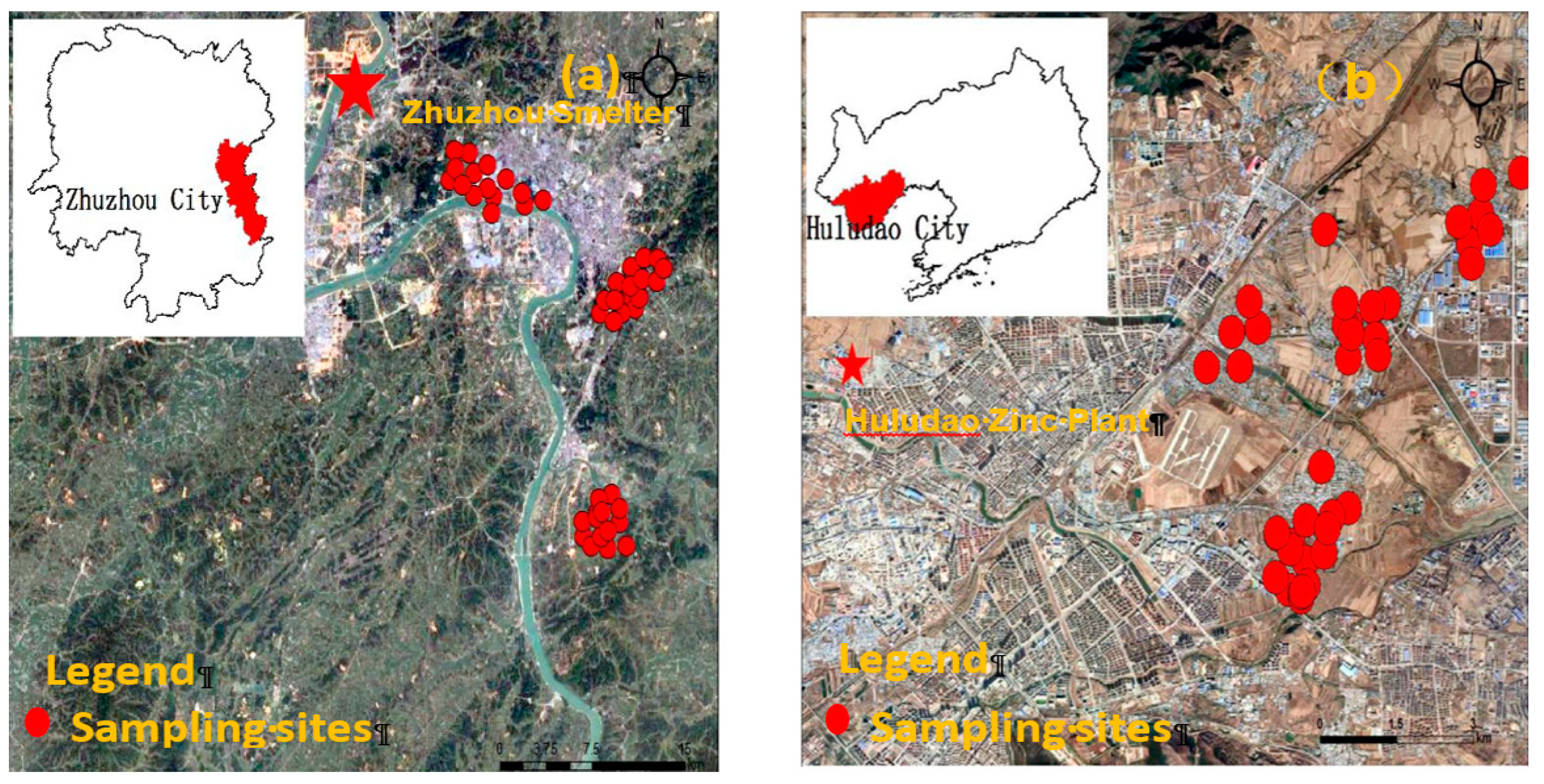

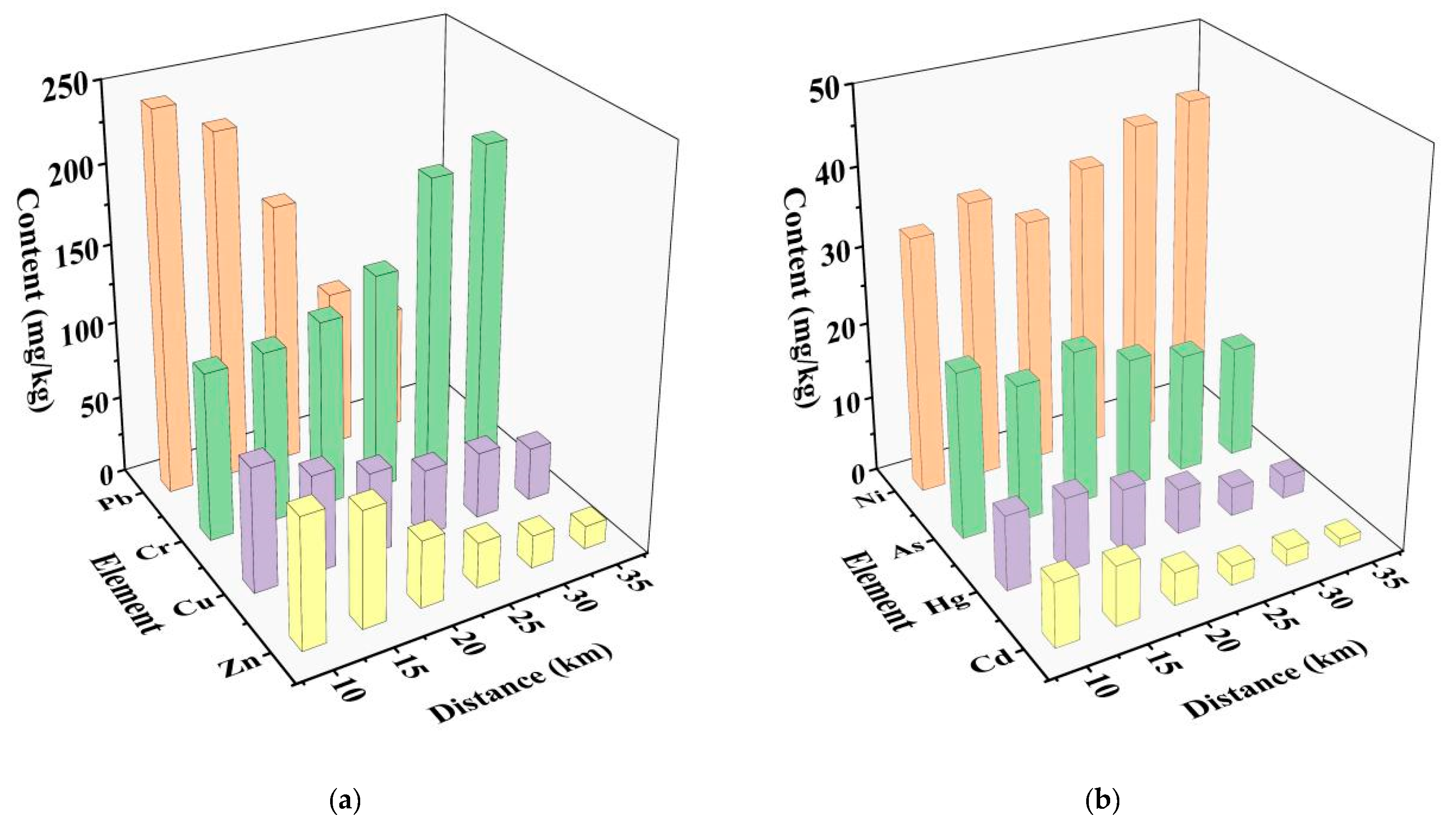
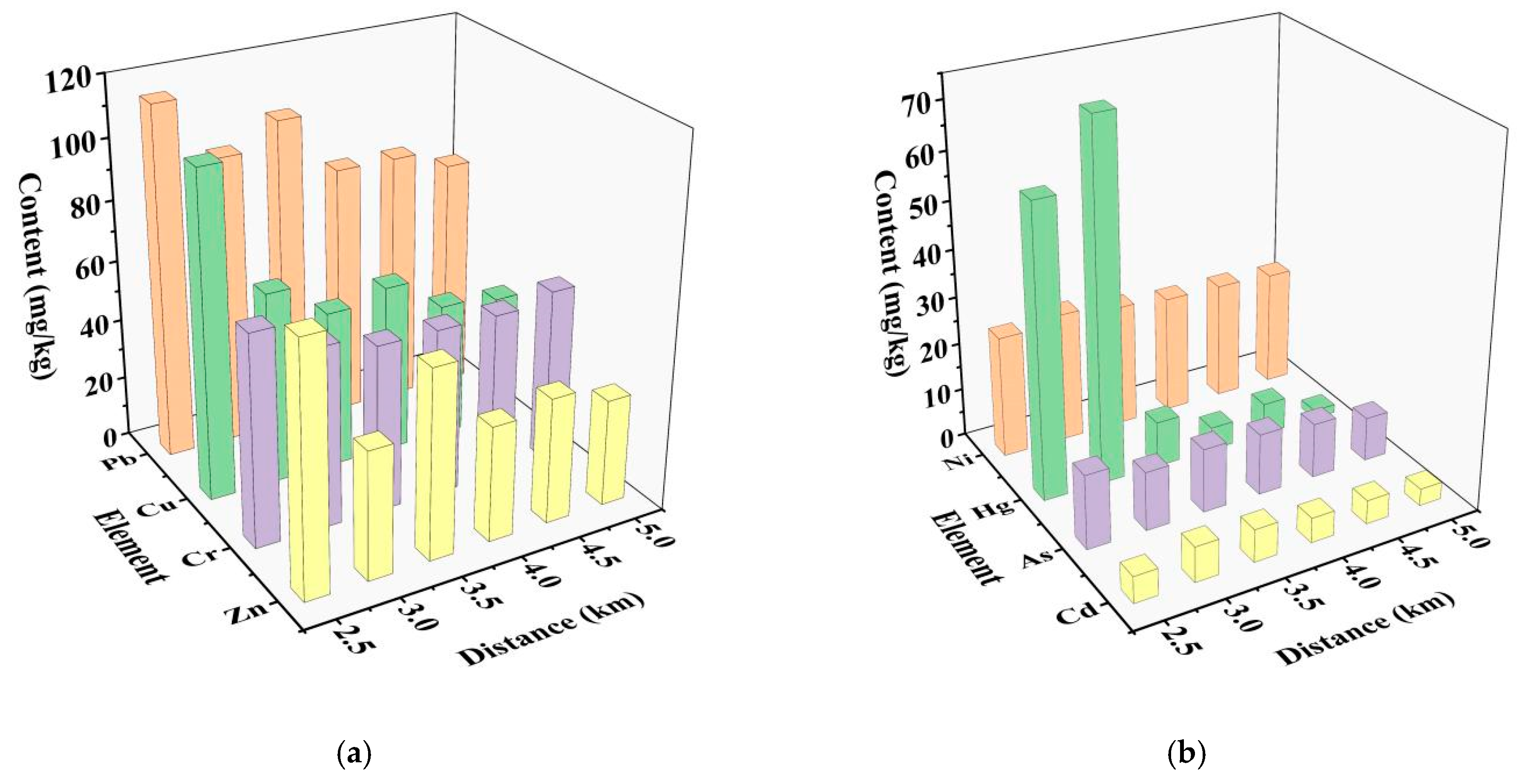
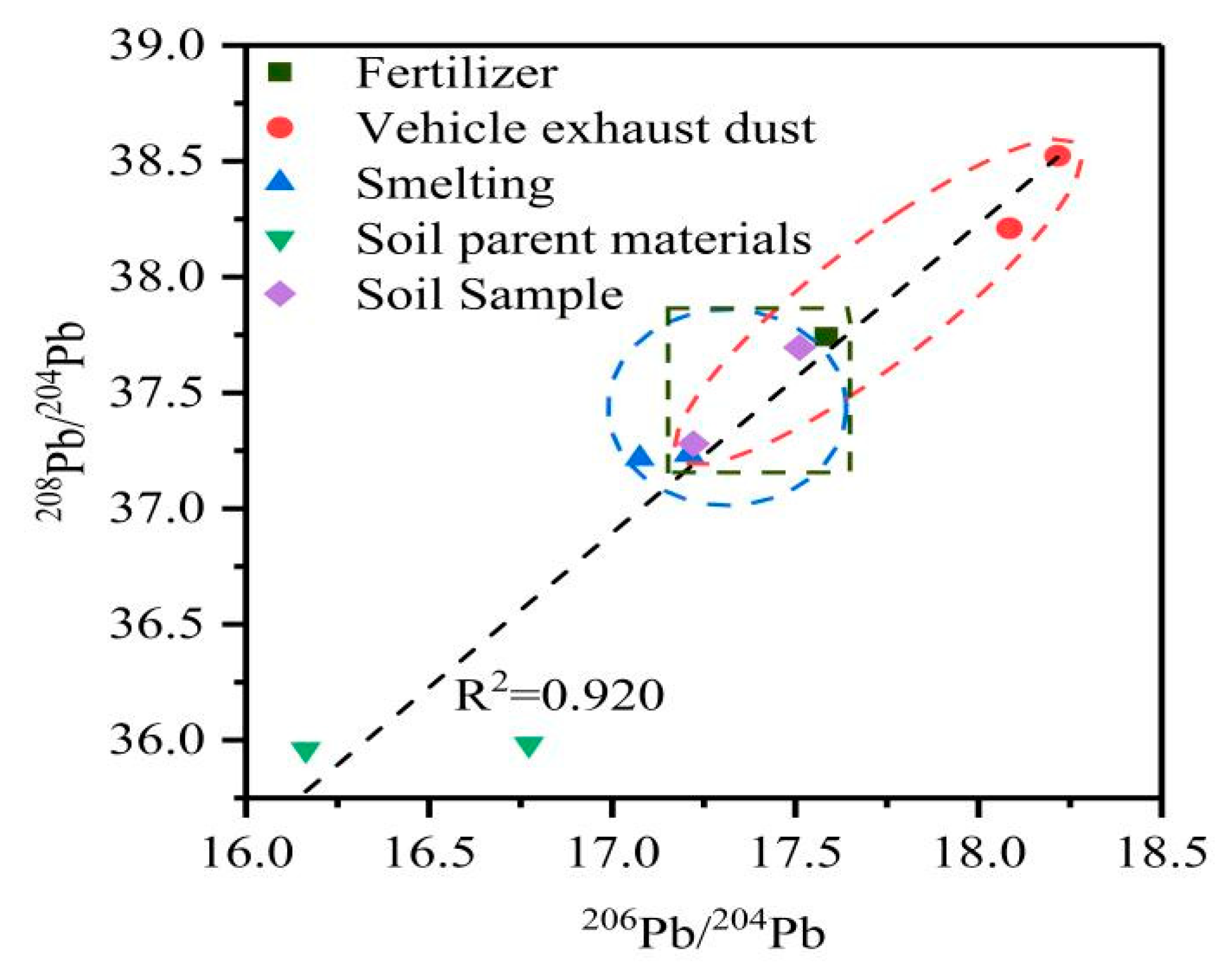

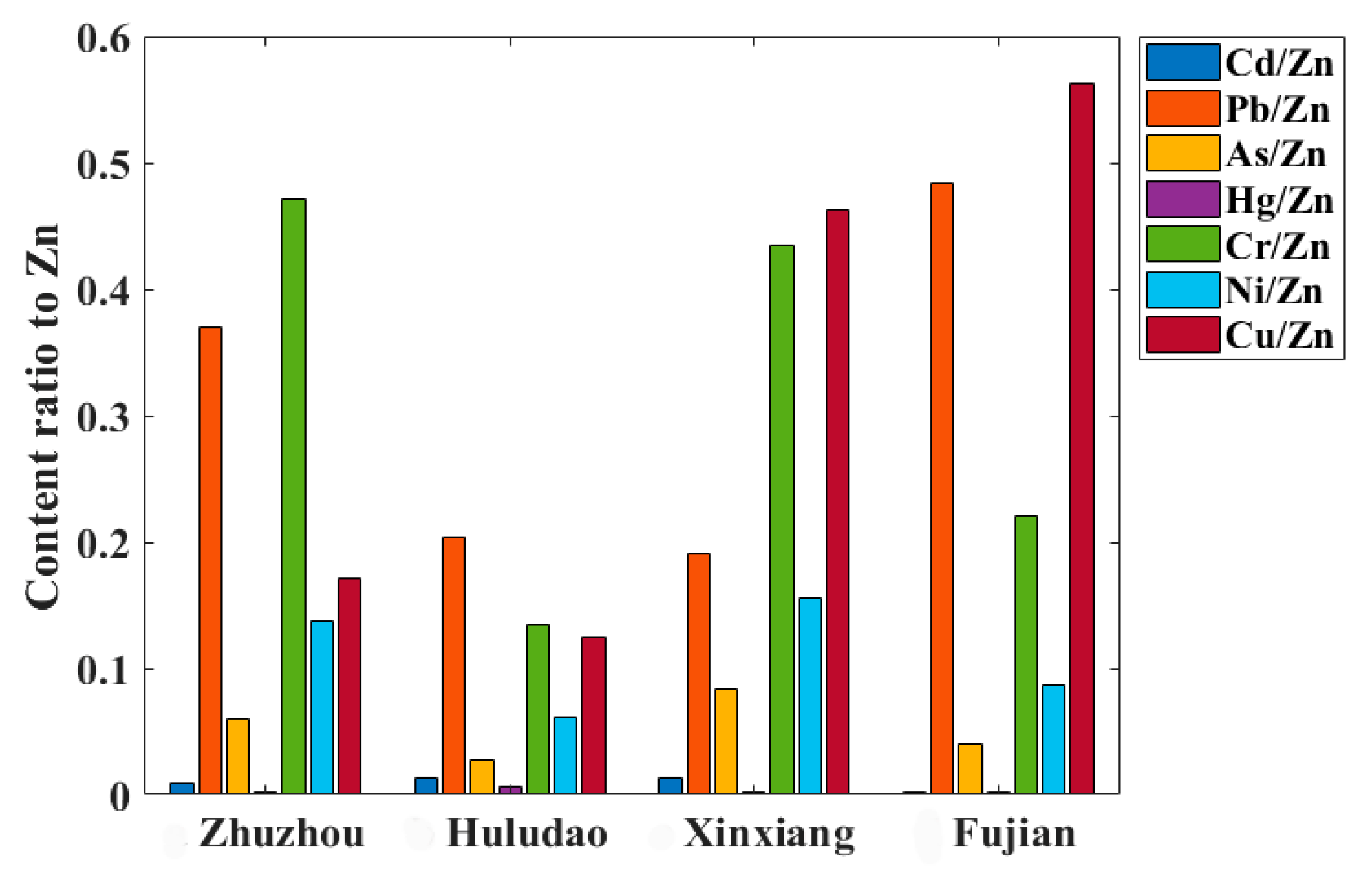
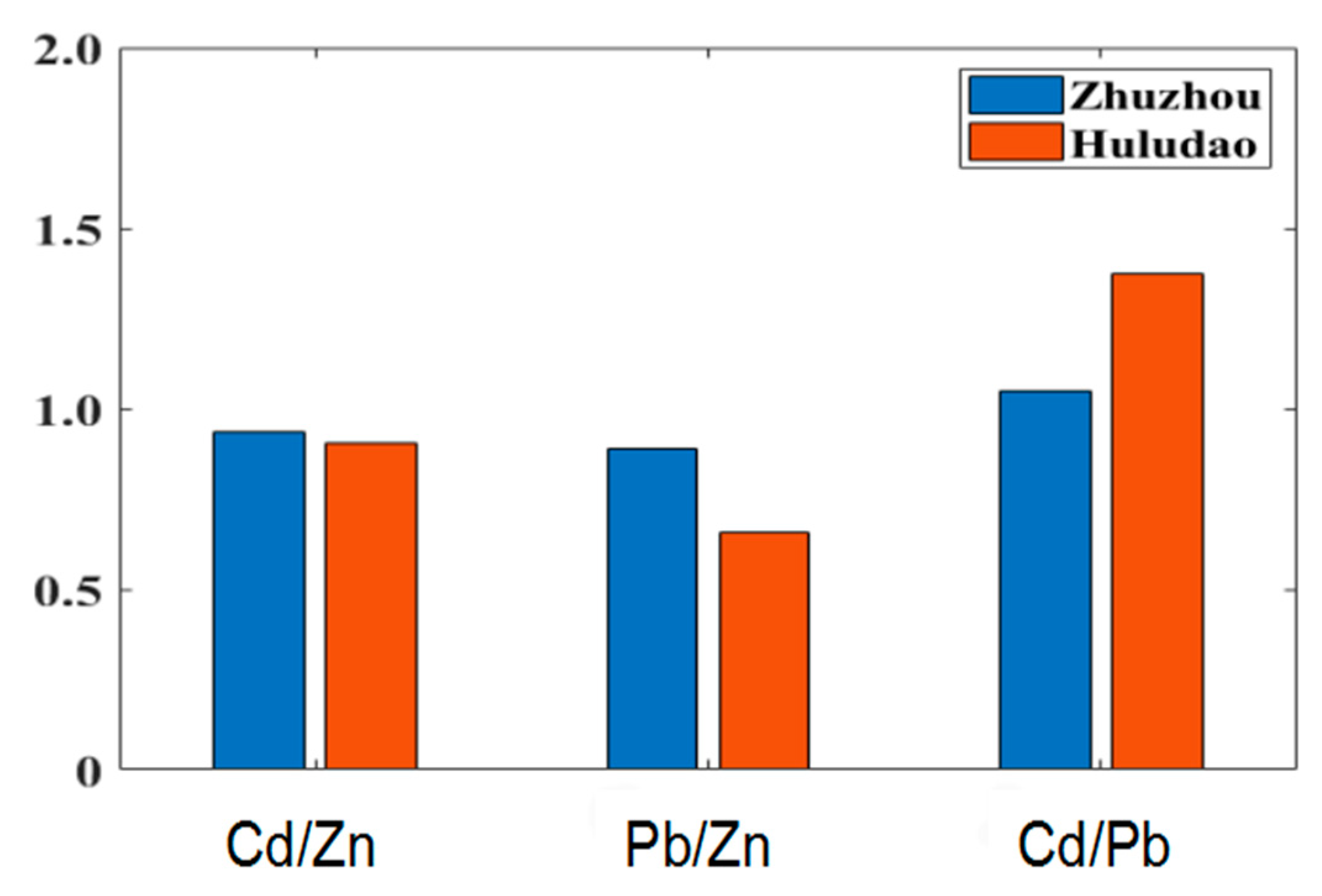
| Class | Pi | NIPI | Quality Value |
|---|---|---|---|
| 1 | Pi ≤ 0.7 | NIPI ≤ 0.7 | Practically uncontaminated |
| 2 | 0.7 < Pi ≤ 1.0 | 0.7 < NIPI ≤ 1.0 | Relatively uncontaminated |
| 3 | 1.0 < Pi ≤ 2.0 | 1.0 < NIPI ≤ 2.0 | Low contamination |
| 4 | 2.0 < Pi ≤ 3.0 | 2.0 < NIPI ≤ 3.0 | Moderate contamination |
| 5 | Pi > 3.0 | NIPI > 3.0 | High contamination |
| Element | Cd | Pb | As | Hg | Cr | Ni | Cu | Zn | |
|---|---|---|---|---|---|---|---|---|---|
| Zhuzhou | Min | 0.51 | 32.20 | 4.98 | 0.08 | 56.10 | 26.40 | 18.50 | 72.50 |
| Max | 9.25 | 307.50 | 23.70 | 2.37 | 212.40 | 48.80 | 85.40 | 922.50 | |
| Mean | 2.31 | 95.10 | 15.44 | 0.48 | 121.28 | 35.38 | 43.96 | 257.30 | |
| SD | 2.58 | 69.78 | 3.45 | 0.40 | 36.49 | 5.49 | 14.62 | 226.26 | |
| BVHP | 0.13 | 29.40 | 15.70 | 0.12 | 71.40 | 31.90 | 27.30 | 94.40 | |
| Percent of over BVHP% | 100.00 | 100.00 | 50.00 | 92.00 | 98.00 | 70.00 | 96.00 | 98.00 | |
| Huludao | Min | 0.96 | 22.50 | 3.60 | 0.07 | 41.00 | 19.00 | 19.80 | 92.30 |
| Max | 22.50 | 210.30 | 27.70 | 20.00 | 77.50 | 37.60 | 151.70 | 1268.20 | |
| Mean | 5.23 | 83.33 | 11.66 | 3.05 | 55.10 | 24.78 | 51.21 | 409.40 | |
| SD | 3.18 | 36.58 | 4.69 | 4.74 | 6.31 | 3.32 | 25.91 | 247.71 | |
| BVLP | 0.11 | 21.10 | 8.80 | 0.04 | 57.90 | 25.60 | 19.80 | 63.50 | |
| Percent of over BVLP% | 100.00 | 100.00 | 82.00 | 100.00 | 24.00 | 92.00 | 100.00 | 100.00 |
| City | Type | Zn | Cd | Reference |
|---|---|---|---|---|
| Henan | Pb smelting | 1.22 | 78.1 | [52] |
| Shaoguan | Pb−Zn smelting | 4.93 | 95.7 | [53] |
| Yongzhou | Pb mining and smelting | 10.09 | 5.38 | [20] |
| Zhuzhou | Pb smelting | 3.2 | 17.8 | This work |
| Huludao | Zn mining and smelting | 6.4 | 47.6 | This work |
| Element | Cd | Pb | As | Hg | Cr | Ni | Cu | Zn | |
|---|---|---|---|---|---|---|---|---|---|
| Zhuzhou | Cd | 1.000 | |||||||
| Pb | 0.675 ** | 1.000 | |||||||
| As | 0.758 ** | 0.573 ** | 1.000 | ||||||
| Hg | 0.714 ** | 0.718 ** | 0.677 ** | 1.000 | |||||
| Cr | 0.436 ** | 0.490 ** | 0.326 * | 0.342 * | 1.000 | ||||
| Ni | 0.141 | 0.176 | −0.032 | 0.043 | 0.701 ** | 1.000 | |||
| Cu | 0.273 | 0.364 ** | 0.111 | 0.245 | 0.592 ** | 0.725 ** | 1.000 | ||
| Zn | 0.708 ** | 0.691 ** | 0.469 ** | 0.652 ** | 0.558 ** | 0.398 ** | 0.485 ** | 1.000 | |
| Huludao | Cd | 1.000 | |||||||
| Pb | 0.847 ** | 1.000 | |||||||
| As | 0.356 * | 0.306 * | 1.000 | ||||||
| Hg | 0.422 ** | 0.551 ** | 0.382 ** | 1.000 | |||||
| Cr | 0.028 | 0.198 | −0.464 ** | 0.103 | 1.000 | ||||
| Ni | 0.126 | 0.281 * | −0.245 | 0.340 * | 0.852 ** | 1.000 | |||
| Cu | 0.627 ** | 0.734 ** | 0.239 | 0.335 * | 0.182 | 0.293 ** | 1.000 | ||
| Zn | 0.882 ** | 0.890 ** | 0.376 ** | 0.364 ** | 0.081 | 0.131 | 0.785 ** | 1.000 |
| Element | (a) Contribution Rate (%) | (b) Contribution Rate (%) | ||||||
|---|---|---|---|---|---|---|---|---|
| Factor 1 | Factor 2 | Factor 3 | Factor 4 | Factor 1 | Factor 2 | Factor 3 | Factor 4 | |
| Cd | 69.7 | 11.8 | 6.1 | 12.4 | 72.7 | 8.7 | 6.3 | 12.3 |
| Zn | 74.7 | 19.2 | 0 | 6.2 | 80.4 | 11.6 | 1.3 | 6.7 |
| Pb | 66.6 | 18.4 | 8.4 | 6.6 | 52.9 | 7.3 | 28.5 | 11.3 |
| Cu | 61.6 | 23.5 | 9.1 | 5.7 | 51.7 | 20.4 | 21.4 | 6.5 |
| Ca | 17.1 | 42.5 | 9.5 | 30.9 | 12.6 | 45.7 | 11.7 | 30.0 |
| Fe | 34.8 | 24.5 | 37.0 | 3.7 | 24.4 | 32.2 | 40.2 | 3.2 |
| Mg | 36.7 | 47.7 | 15.6 | 0 | 27.3 | 49.8 | 22.9 | 0 |
| Al | 33.8 | 18.0 | 43.8 | 4.4 | 19.5 | 28.3 | 49.2 | 3.0 |
| K | 19.0 | 1.6 | 69.9 | 9.5 | 20.9 | 0.3 | 72.7 | 6.1 |
| Hg | 10.8 | 0.6 | 0 | 88.6 | 1.0 | 10.7 | 3.5 | 84.8 |
| Ni | 32.7 | 22.7 | 39.6 | 5.0 | 23.2 | 26.5 | 45.9 | 4.4 |
| Cr | 33.0 | 23.0 | 40.2 | 3.7 | 25.5 | 24.9 | 46.4 | 3.2 |
| As | 34.1 | 0 | 56.5 | 9.4 | 32.6 | 6.7 | 58.3 | 2.4 |
| Total | 37.6 | 22.4 | 26.9 | 13.1 | 34.1 | 24.3 | 29.4 | 12.2 |
Publisher’s Note: MDPI stays neutral with regard to jurisdictional claims in published maps and institutional affiliations. |
© 2021 by the authors. Licensee MDPI, Basel, Switzerland. This article is an open access article distributed under the terms and conditions of the Creative Commons Attribution (CC BY) license (https://creativecommons.org/licenses/by/4.0/).
Share and Cite
Yu, D.; Wang, J.; Wang, Y.; Du, X.; Li, G.; Li, B. Identifying the Source of Heavy Metal Pollution and Apportionment in Agricultural Soils Impacted by Different Smelters in China by the Positive Matrix Factorization Model and the Pb Isotope Ratio Method. Sustainability 2021, 13, 6526. https://doi.org/10.3390/su13126526
Yu D, Wang J, Wang Y, Du X, Li G, Li B. Identifying the Source of Heavy Metal Pollution and Apportionment in Agricultural Soils Impacted by Different Smelters in China by the Positive Matrix Factorization Model and the Pb Isotope Ratio Method. Sustainability. 2021; 13(12):6526. https://doi.org/10.3390/su13126526
Chicago/Turabian StyleYu, Danyang, Jingran Wang, Yanhong Wang, Xueli Du, Guochen Li, and Bo Li. 2021. "Identifying the Source of Heavy Metal Pollution and Apportionment in Agricultural Soils Impacted by Different Smelters in China by the Positive Matrix Factorization Model and the Pb Isotope Ratio Method" Sustainability 13, no. 12: 6526. https://doi.org/10.3390/su13126526
APA StyleYu, D., Wang, J., Wang, Y., Du, X., Li, G., & Li, B. (2021). Identifying the Source of Heavy Metal Pollution and Apportionment in Agricultural Soils Impacted by Different Smelters in China by the Positive Matrix Factorization Model and the Pb Isotope Ratio Method. Sustainability, 13(12), 6526. https://doi.org/10.3390/su13126526






